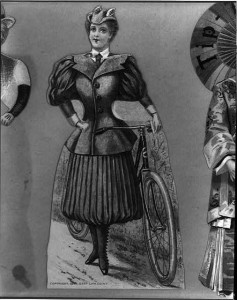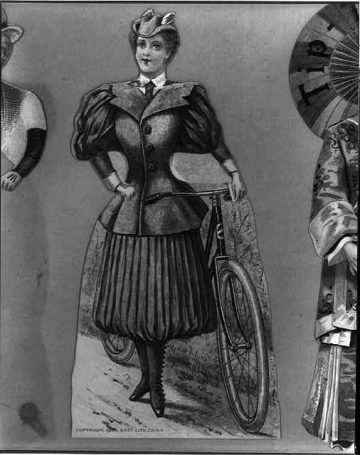This week, I started reading Our Bodies, Our Bikes and found a quote from 1885 I hadn’t seen before, though it must be somewhat well-known as it’s quoted in the April 1985 Friend magazine in an article on the history of the bicycle.
The mere act of riding a bicycle is not in itself sinful and if it is the only means of reaching the church on a Sunday, it may be excusable.
This made me wonder if the bicycle was a hot topic in Mormonism, so I checked if it was mentioned in the original Women’s Exponent. And it was. Four times.
Chronologically, the first time “bicycle” was mentioned was in the June 15, 1892 issue, in an article written by someone with the initials “AWC.” She had gone on a trip to Heidelberg and wrote an article titled “A Day in Heidelberg” describing her experience. Her bicycle quote:
The city streets are narrow and crooked, the buildings tall and old and dark, and so shading the streets that it is positive relief to enter the principal promenade, the Anlage where the walks and drives are broader, and there among the border shrubs and trees are pretty rustic seats where one can watch the fashionable ladies ,the children with their nurses, the pretty girls with their staid chaperones, and the gaily attired students strolling, riding, bicycle riding.
The next time “bicycle” is mentioned is in the July 15, 1894 issue, in an article titled Saltair: A Famous Pleasure Resort about an “Old Folks Day” event held there. The https://exponentii.org/wp-content/uploads/2021/12/IMG_5173-scaled-1.jpg states, “The Bicycle drill was a genuine amusement, and everybody enjoyed it immensely, judging from the vociferous applause.” I’m not sure what a “Bicycle Drill” consisted of. I’m guessing it’s some sort of race, but if anyone knows better, please share!
Also, that year, the “Miscellaneous” section of the September 1 issue, mentioned the bicycle. The “Miscellaneous” articles in each issue shared current news. This time the section included this:
Miss WILLARD and Miss Gordon returned to “The Eagle’s Nest” chalet, in the Catskill Mountains, July 27, where they will have two stenographers, and continue their work for the W. C. T. U. Miss Willard is to complete her “Handbook of History and Methods,” her booklet on “How I Learned the Bicycle, with reflections by the Way,” and, besides preparing her annual address, she will send out leaflets and articles for the press, and will write an https://exponentii.org/wp-content/uploads/2021/12/IMG_5173-scaled-1.jpgial each week for the Union Signal, the organ of the White Ribbon movement.
Here, the Miss Willard is Frances Willard, a suffragist who founded the Women’s Christian Temperance Union (W. C. T. U., above), which was symbolized by a white ribbon. Her friend, secretary, and biographer, Anna Adams Gordon later became the president of the WCTU.
The final mention of the bicycle in the Women’s Exponent comes from Elsie Ada Faust’s address from the Alumni Banquet at the University of Utah. Her speech was published in the February 15, 1897 issue of the Women’s Exponent and was titled, “The New Woman.” In it, she outlined what “the New Woman” is like and addressing the concerns that women were becoming “too independent” with treasures such as,
Writers and speakers have been so busy separating the sexes and theoretically endowing each with separate elements of character that they have not had time to see (and the misunderstanding of this subject depends largely on the lack of seeing) that there is no difference, for if we look well we will find that all the vanities and faults supposed to be wholly feminine may be found just as often in man as in woman; and all the noble traits and attributes of which men have assumed a monopoly appear just as often in woman.
I really want to share the whole address, but you can find it in the link above. She uses the bicycle as a metaphor in the next section:

The new woman, or rather woman in her new light, does not look down on her fellow man as is commonly supposed; not at all, for she knows however short he may fall below the ideal, she may not do any better. And you will find, though bicycle mounted, with her voluminous sleeves set to the breezes, she will not take more than her half of the road. All she asks is equal start and privileges down the race of life.
Victorian opinions on bicycles varied greatly, but it seems that Victorian Mormonism looked on bicycling positively. If you are interested in a great book on the intersection of first wave feminism and advent of the bicycle, check out Wheels of Change.








5 Responses
Love it!! What a great analogy-sharing the road!
Thanks for the link to “The New Woman” speech. The whole thing is fabulous!
Yes it is!
How wonderful to read about our Victorian foremothers not only biking, but also arguing against gender essentialism. How did you find all the quotes? Is the original Exponent available as a searchable archive?
Yes, the link for searching them is here. The search function isn’t 100% because some of the letters in the print are old and blurry and the computer can’t understand them, but it’s pretty good.